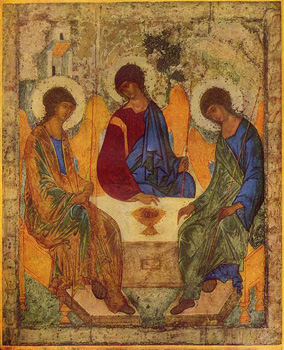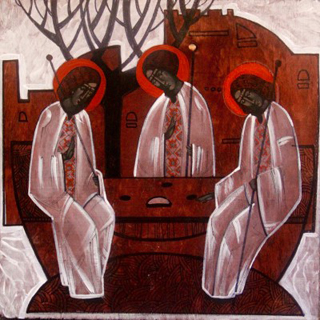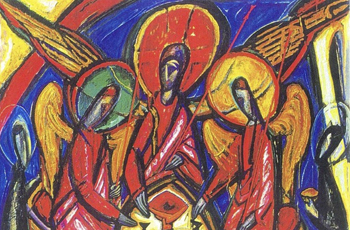For Sunday June 7, 2020
Lectionary Readings (Revised Common Lectionary, Year A)
Genesis 1:1-2:4a
Psalm 8
2 Corinthians 13:11-13
Matthew 28:16-20
Even at the best of times, it’s hard to get excited about Trinity Sunday. Most Christian festivals honor events that are fun to describe and dramatize. The angel Gabriel’s appearance to Mary, Jesus’s transfiguration atop a mountain, his birth and resurrection, the arrival of the Holy Spirit at Pentecost. But Trinity Sunday invites us to celebrate an idea. A theological abstraction that’s beyond our understanding. One in three? Three in one? Huh?
Needless to say, we are not living in the best of times. As I write this essay, several American cities are descending into chaos as citizens protest the horrific murder of George Floyd. What’s being uncovered is centuries’ old injustice, and the pain spilling into our streets is too deep for words. Meanwhile, the Covid-19 pandemic continues to devastate our planet. All over the world, catastrophic headlines darken our days. Many of us are tired, heartsick, anxious, and overwhelmed. Some of us are ill. Some of us are mourning loved ones who have died. Some of us are facing economic uncertainty or ruin. Some of us are devastated by the divisions and inequalities that infect our communities. Some of us are angry about what’s happening in our national politics. Some of us are barely hanging onto belief in one God. Now the Church wants us to contemplate three? Why?
If you’re like me, you’ve been at the receiving end (or the giving end) of many well-meaning but inadequate attempts to explain the Triune God: “Oh, well, the Trinity is sort of like water! You know, liquid, vapor, and ice? Three phases, one entity? The Trinity is like that!” Or, “Think of a tree! The roots, the trunk, and the branches. Three parts, one tree. Or an egg. The shell, the eggwhite, and the yolk. Or a triangle. Or St. Patrick’s shamrock: three petals, one clover. Or (courtesy of John Wesley), three candles in a room, one light by which to read.
All of these analogies — beautiful though they are — fall short, and none of them address the deeper question: Why should we care? What difference does the three-in-one make? Fine, God is Father, Son, and Holy Spirit. So what? Given the state our world is in right now, why should the Christian doctrine of the Trinity matter?
 |
Well, maybe for starters, we need the Trinity to teach us a lesson in humility. In this divided and polarized moment, when religion is so often used as a weapon of war, it’s easy to imagine that we have the monopoly on the divine. It’s easy to grow smug and complacent, and to assume that our articulation of faith, our liturgy, our denomination, and our worship practices capture the best version of who God is and what God desires. One thing the Trinity does by its very complexity is challenge this assumption. The truth of God will always exceed us. The truth of God will always be more than our tiny, easily overwhelmed minds can bear. The truth of God will always confront, convict, and remake us, even as it soothes and affirms us. This is a good thing. It is good and right and necessary to remember that we are created in God’s image. We are not at liberty to reshape God into ours.
So we begin our celebration of Trinity Sunday with the humble acknowledgement that we are out of our depth. We begin in fear and trembling, rejecting our own arrogance, and recognizing that when it comes to comprehending God, we are wholly dependent on divine revelation.
But then what? Why else does the Trinity matter? Perhaps it matters right now because what we believe about the nature of God — in whose image we are created, as our reading from Genesis affirms — is a matter of life and death. How can we know who we are, and what we were made for, and who we should be to each other, unless we know who God is? If the desire and delight of God is that we live into the fullness of the Imago Dei, then we must commit ourselves to studying and experiencing God’s nature in all of its fullness and complexity.
So. Is there anything we can say with assurance, or honor with abandon on this Trinity Sunday? Franciscan priest and theologian Richard Rohr argues that caring about the Trinity requires orienting ourselves in a new way: “Don’t start with the One and try to make it into Three,” he writes in his book, The Divine Dance. “Start with the Three and see that this is the deepest nature of the One.”
Start with the Three and see that this is the deepest nature of the One. What might it look like to follow Rohr's advice? What will we discover about God’s character, God’s personality, and God’s priorities, if we see threeness as the ground and essence of God’s being? Here are a few possibilities:
We’ll see that God is dynamic. If God is triune, God does not exist in monolithic stasis. Rather, God’s self is fluid. God moves. Or to use Rohr’s language again: God flows, and God is flow. God dances, and God is dance. Regardless of whether we'll learn to tolerate the discomfort of divine fluidity or not, we worship a God who is always on the move, always spilling over, always organic, always a surprise. His coherence doesn’t require him to be rigid. “Expand, do not contract God,” Kenn Storck writes in his poem, “The Holy Trinity,” “For God is the Great Iconoclast.”
Why does this matter for us? I think it matters because we are prone to rigidity and stasis. We don’t like change, and we are often reluctant to embrace what is new, what is unfamiliar, what is uncomfortable. But if God’s nature is flow and movement and dance, then we need to find the courage to enter into that same flow, movement, and dance. We must be willing to evolve.
We’ll see that God is diverse. If God exists in three persons, then each person has his (or her) own way of embodying and expressing goodness, beauty, love, and righteousness. As Rohr puts it, the Trinity affirms that there is an intrinsic plurality to goodness. “Goodness isn’t sameness,” he writes in The Divine Dance. “Goodness, to be goodness, needs contrast and tension, not perfect uniformity.” If God can incarnate goodness through contrast and tension, then it’s worth asking why we can’t. Or won’t. Why do we fear difference so much when difference lies at the very heart of God’s nature?
 |
Given the racial divisions tearing the United States apart at this very moment, I can’t imagine a more relevant characteristic to ponder than God’s innate diversity. As churches, communities, and countries, we will not survive unless we learn how to live gracefully and peaceably with difference. We will not heal unless we’re honest about our fears, penitent about our histories, and unrelenting in our longing for God’s diverse nature to be realized in its fullness among us.
We’ll see that God is communal. It’s one thing to say that God values community. Or that God thinks community is good for us. It’s altogether another to say that God is communal. That God is relationship, intimacy, connection, and communion. Evidence of this divine characteristic runs all through the Scriptures. When God the Son is baptized, God the Spirit descends in the form of a dove, and God the Father parts the heavens to speak delight and affirmation. The Spirit of God drives the Son of God into the wilderness, for a time of testing and preparation. In the Garden of Gethsemane, the Son of God cries out to God the Father for help and solace. It is God the Father who raises the crucified Son, vindicating his death through resurrection. Throughout the Gospel story, the Three exist interdependently, leaning into each other.
If God is interactive at God’s very heart — if Three is the deepest nature of the One — then what are we doing when we isolate ourselves from each other? When we decide to go it alone? When we privilege independence and autonomy over companionship and mutuality? When we prioritize our individual “rights” over our care and concern for the most vulnerable among us? If the Trinity really is more than a bit of dusty doctrine the early Church fought over, then we dare not take lightly the life-changing power of the communal. God is Relationship, and it is in relationship — with God, ourselves, each other, and the world — that we experience and embody God’s nature.
We'll see that God is hospitable. In the 15th century, Russian iconographer Andrei Rublev created “The Hospitality of Abraham,” also known as “The Trinity,” one of the most well known and beloved icons in Christendom. In it, the Father, the Son, and the Holy Spirit (depicted as the three angels who appeared to Abraham near the great trees of Mamre), sit around a table, sharing food and drink. Their faces are nearly identical, but they’re dressed in different colors. The Father wears gold, the Son blue, and the Spirit green. The Father gazes at the Son. The Son gazes back at the Father, but gestures towards the Spirit. The Spirit gazes at the Father, but points toward the Son with one hand, and opens up the circle with the other, making room for others to join the sacred meal. As a whole, the icon exudes adoration and intimacy — clearly, the three persons around the table respect and enjoy each other. But it also exudes openness. There is space at the table for the viewer of the icon. For me. For us. As if to say, the point of the great Three-in-One is not exclusivity — God is not a middle school clique — but rather, radical hospitality. The point of the Three is always to add one more, to extend the invitation, to make the holy table more expansive and more welcoming. In fact, the deeper the intimacy between the Three grows, the roomier the table becomes. Likewise, the closer we draw to the adoration of the Three, the wider and more hospitable our hearts must grow towards the world.
 |
And finally, we'll see that God is sacrificial love. The Trinity at its heart is an expression of deep, unfaltering, and life-giving love between the Father, the Son, and the Holy Spirit. The relationship between the persons of the Godhead is not a relationship of domination, power-mongering, manipulation, or jealousy. It is a relationship of unselfish, sacrificial love. Which begs the question: if God’s very being is grounded in love, and we are created in God’s image, then who are we? What are we? Are we, like the Triune God whose imprint we bear, creatures motivated first and foremost by love? Is love what we are known for? If not, then what are we doing with our lives? What does our piety amount to?
Why should we care about the three-in-one? We should care because we are children of the Trinity at a time when the world is reeling and desperate. We are the children of a mysterious, fluid, diverse, communal, hospitable, and loving God who wants to guide us into the whole truth of who God is and who we are. We should care because the mystery of the Trinity has the power to transform our hearts, leading us towards coherence and dynamism, unity and diversity, hospitality and self-giving love. This week and always, may our lives reflect the transformative beauty of the Triune God.
Debie Thomas: debie.thomas1@gmail.com
Image credits: (1) Wikimedia.org; (2) Cathedral of the Incarnation; and (3) Marginalia; Los Angeles Review of Books.





